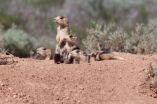(Press-News.org) FROSTBURG, MD (March 7, 2013)—Prairie dogs pull up stakes and look for a new place to live when all their close kin have disappeared from their home territory--a striking pattern of dispersal that has not been observed for any other species. This is according to a new study published in Science by behavioral ecologist John Hoogland, Professor at the University of Maryland Center for Environmental Science's Appalachian Laboratory. He has been studying the ecology and social behavior of prairie dogs in national parks in Arizona, South Dakota, and Utah for the last 40 years.
For most animals, individuals leave a territory, or disperse, to avoid competition with nearby relatives, such as mother or sibling. For three species of prairie dogs, however, individuals are more likely to disperse in the absence of nearby close kin. Females are 12.5 times more likely to disperse when close kin are absent for one species, and 5.5 times more likely for another species.
Prairie dogs are large, burrowing rodents of the squirrel family. They live in colonies in grassland ecosystems of western North America, and forage aboveground on grasses and other plants from dawn until dusk. Within colonies, prairie dogs live in territorial, contiguous family groups called clans, which typically contain one mature male, two to five mature females, and one or two adolescent males. Hoogland has been trying to figure out which individuals disperse from the territory of birth, and why.
"The key to our research is that we live with the prairie dogs for five months of every year," says Hoogland. "Students and I climb into our observation towers at the study-colony at dawn each morning before the prairie dogs wake up, and we stay there until the last individual has submerged into its burrow for the night."
The prairie dogs all have numbered eartags (which are inserted at weaning and remain their entire lifetime), and the flank of each individual is uniquely marked with fur-dye so that it can be identified from a distance. The researchers therefore can document which prairie dogs get captured by predators, which ones mate and produce offspring, and which ones disperse to new territories.
"Prairie dogs are excellent models for a study of dispersal because they are easy to live-trap, mark, and observe," says Hoogland, "And they usually move only short distances to nearby territories."
Why are prairie dogs so different regarding dispersal? According to Hoogland, prairie dogs resemble other animals and compete with nearby kin for resources such as burrows and mates. But prairie dogs also cooperate with kin in the excavation of burrows that can be as deep as 15 feet; in defense of the home territory against prairie dogs from other territories; by giving alarm calls when a large predator such as a coyote attacks; and by helping to chase small predators such as long-tailed weasels. Another important cooperative behavior is communal nursing (the suckling of non-offspring), which can be life-saving for the unweaned offspring of close kin when the mother of those offspring dies for any reason.
Hoogland hypothesizes that the benefits of cooperation with close kin exceed the costs of competition with those same close kin. When all close kin disappear, individuals disperse because they have nobody with whom to cooperate. When the option is available, prairie dogs frequently disperse into a territory that contains close kin who dispersed there earlier—so that benefits from cooperation are once again available.
Scientists at the University of Maryland Center for Environmental Science's Appalachian Laboratory in Frostburg actively study the effects of land-use change on terrestrial and freshwater ecosystems and how human activity may influence their health and sustainability on local, regional and global scales. The scientific results help to unravel the consequences of environmental change, manage natural resources, restore ecosystems, and foster ecological literacy.
INFORMATION:
UNIVERSITY OF MARYLAND CENTER FOR ENVIRONMENTAL SCIENCE
The University of Maryland Center for Environmental Science unleashes the power of science to transform the way society understands and manages the environment. By conducting cutting-edge research into today's most pressing environmental problems and training the next generation of environmental scientists, we are developing new ideas to help guide our state, nation, and world toward a more sustainable future. From the mountains to the sea, our five research centers include the Appalachian Laboratory in Frostburg, the Chesapeake Biological Laboratory in Solomons, the Horn Point Laboratory in Cambridge, the Institute of Marine and Environmental Technology in Baltimore, and the Maryland Sea Grant College in College Park. http://www.umces.edu
Prairie dogs disperse when all close kin have disappeared
2013-03-08
ELSE PRESS RELEASES FROM THIS DATE:
Drugs targeting blood vessels may be candidates for treating Alzheimer's
2013-03-08
University of British Columbia researchers have successfully normalized the production of blood vessels in the brain of mice with Alzheimer's disease (AD) by immunizing them with amyloid beta, a protein widely associated with the disease.
While AD is typically characterized by a build-up of plaques in the brain, recent research by the UBC team showed a near doubling of blood vessels in the brain of mice and humans with AD.
The new study, published online last week in Scientific Reports, a Nature journal, shows a reduction of brain capillaries in mice immunized with ...
Engineers develop techniques to boost efficiency of cloud computing infrastructure
2013-03-08
Computer scientists at the University of California, San Diego, and Google have developed a novel approach that allows the massive infrastructure powering cloud computing as much as 15 to 20 percent more efficiently. This novel model has already been applied at Google. Researchers presented their findings at the IEEE International Symposium on High Performance Computer Architecture conference Feb. 23 to 27 in China.
Computer scientists looked at a range of Google web services, including Gmail and search. They used a unique approach to develop their model. Their first ...
The future of ion traps
2013-03-08
Recently Science Magazine invited JQI fellow Chris Monroe and Duke Professor Jungsang Kim to speculate on ion trap technology as a scalable option for quantum information processing. The article is highlighted on the cover of this week's issue, which is dedicated to quantum information. The cover portrays a photograph of a surface trap that was fabricated by Sandia National Labs and used to trap ions at JQI and Duke, among other laboratories.
Trapped atomic ions are a promising architecture that satisfies many of the critical requirements for constructing a quantum computer. ...
NASA's TRMM satellite sees Tropical Cyclone 19P form
2013-03-08
NASA's Tropical Rainfall Measuring Mission satellite noticed areas of heavy rainfall in low pressure System 92P hours before it became the nineteenth tropical cyclone of the Southern Pacific Ocean.
NASA's TRMM satellite captured a look at the rainfall rates within low pressure System 92P on March 7 at 0023 UTC (March 6 at 7:23 p.m. EST), just hours before it became Tropical Cyclone 19P (TC 19P). TRMM data indicated that heavy rain was falling at a rate of 2 inches/50 mm per hour around the center of circulation, and that some of the thunderstorms were powerful as they ...
Trauma simulation technique makes better journalists
2013-03-08
This press release is available in French.
Montreal, March 7, 2013 – Just hours after the tragic shooting of 27 victims at Sandy Hook Elementary School, Twitter was overloaded with messages slamming reporters for interviewing children involved in the tragedy. While some of the journalists probably knew better but wanted the story at all costs, others were rookie reporters facing ethical decisions for the first time and unaware of the impact these interviews might have on the young survivors.
Past studies have documented that new journalists can cause a number of ...
Hubble finds birth certificate of oldest known star
2013-03-08
A team of astronomers using NASA's Hubble Space Telescope has taken an important step closer to finding the birth certificate of a star that's been around for a very long time.
"We have found that this is the oldest known star with a well-determined age," said Howard Bond of Pennsylvania State University in University Park, Pa., and the Space Telescope Science Institute in Baltimore, Md.
The star could be as old as 14.5 billion years (plus or minus 0.8 billion years), which at first glance would make it older than the universe's calculated age of about 13.8 billion ...
Small physician practices that care for children unprepared to become medical homes
2013-03-08
Ann Arbor, Mich. — Primary care practices around the country are being encouraged and even paid to become "medical homes," but small practices might be at a significant disadvantage in this race to improve health care for children, according to a new study by child health experts at C.S. Mott Children's Hospital.
Efforts around the country to improve health care for children have increasingly focused on the medical home as a model to make primary care practices more accessible, comprehensive, and focused on quality improvement. Since 2008, practices could become officially ...
Biologists produce rainbow-colored algae
2013-03-08
What can green algae do for science if they weren't, well, green?
That's the question biologists at UC San Diego sought to answer when they engineered a green alga used commonly in laboratories, Chlamydomonas reinhardtii, into a rainbow of different colors by producing six different colored fluorescent proteins in the algae cells.
While fluorescent green, red, blue and yellow may be all the rage this year for running shoes and other kinds of sporting gear, fluorescent algae hasn't been a style trend yet in scientific laboratories. But in announcing their achievement in ...
Stocking Florida bass in Texas reservoirs may alter stream systems connected to stocked reservoirs
2013-03-08
WACO, Texas (March 7, 2013) - A genetic analysis by Baylor University biologists suggests that the stocking of Florida bass in Texas reservoirs impacts bass populations far beyond the actual stocking location.
The native largemouth bass has a long and nearly continuous stocking history in Texas. However, the Florida bass is widely considered a better sport fish because it grows to a greater size. Subsequently, stocking efforts in Texas reservoirs have transitioned from largemouth bass to Florida bass.
The Baylor researchers analyzed the genetic composition of 69 largemouth ...
Net advantage
2013-03-08
Malaria, the leading cause of death among children in Africa, could be eliminated if three-fourths of the population used insecticide-treated bed nets, according to a new study from the National Institute for Mathematical and Biological Synthesis (NIMBioS).
The study, which uses a mathematical model, found that use of insecticide-treated bed nets or ITNs positively affected the infection's reproduction number, or R, which is the primary epidemiological number used to determine the degree which a disease can spread through a population. The model concludes that if 75 percent ...



